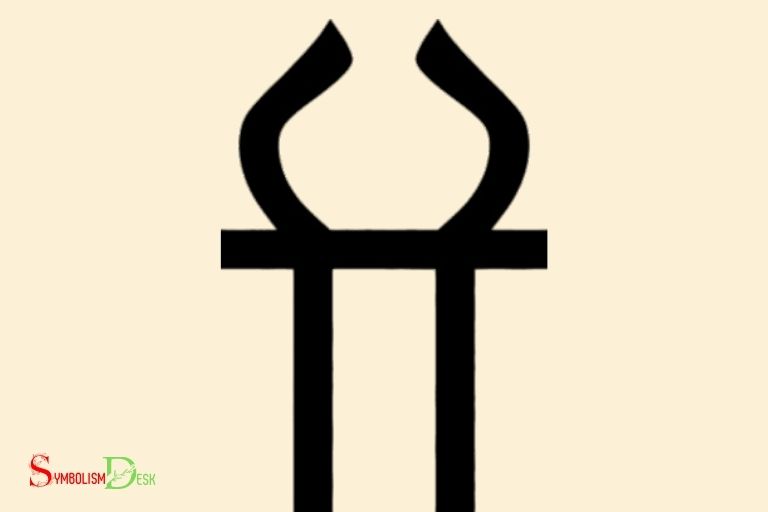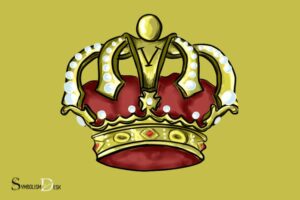What Does Hestia Symbol Mean? Home!
The Hestia symbol represents the Greek goddess of hearth, home, and domestic life, emphasizing the importance of warmth, stability, and family bonding in ancient Greek culture.
Hestia, the eldest sister of Zeus, was a virgin goddess who played a vital role in the daily lives of ancient Greeks.
She was the embodiment of the home’s safety, warmth, and spirit, ensuring that the family remained united and protected.
Her symbols, which include the hearth, fire, and a kettle or veil, reflect her association with these fundamental aspects of life.
Hestia’s symbols hold great significance in understanding her role in ancient Greek society.
The hearth represents the center of the home, while fire symbolizes warmth, sustenance, and security.
The kettle or veil, on the other hand, denotes her status as a virgin goddess and the purity she embodies. Together, these symbols highlight Hestia’s importance in fostering a harmonious and safe home environment.
Meaning and Symbolism of Hestia
| Symbol | Meaning |
|---|---|
| Hearth | Hestia’s symbol of the hearth represents the central focus of the home, family life, and domestic stability. |
| Fire | The sacred fire of Hestia symbolizes warmth, protection, and the transformative power of fire in both the home and the community. |
| Circle | A circle represents the inclusion of people and the unity in families and communities, as Hestia is the goddess of hospitality. |
| Veil or Modesty | Hestia is often depicted wearing a veil, symbolizing modesty and humility. This reflects her role as a gentle, nurturing figure. |
| Staff | The staff is a symbol of authority and support, which signifies Hestia’s role in maintaining order and harmony within the home. |
Key Takeaway

Five Fascinating Facts About Hestia
Introduction To Hestia
Hestia is a greek goddess, known as the virgin goddess of the hearth and home. She is one of the twelve olympian deities, and her symbol is an eternal flame.
In this section, we will provide a brief overview of hestia, discuss the historical context of her worship, and explore the origin of her name.
Brief Overview Of Hestia
- Hestia is the goddess of the hearth, home, and family in greek mythology.
- She is one of the twelve olympian gods and goddesses, and her siblings include zeus, poseidon, and demeter.
- Hestia is known for her role as the guardian of the hearth, and her presence was believed to bring warmth, comfort, and security to a household.
Historical Context Of Hestia
- Worship of hestia dates back to ancient greece and was a central feature of domestic life.
- Hestia was revered for her selfless and pure nature, and her followers believed that she provided protection and blessings for those who welcomed her into their homes.
- In ancient greece, hestia was honored in public hearths located in the center of cities, as well as in private homes.
Origin Of Her Name
- Hestia’s name is derived from the greek word “hestia,” meaning hearth or fireplace.
- She was often depicted with a torch or flame, symbolizing the eternal flame of the hearth.
- Hestia’s name is also connected with the greek word “hestos,” which means standing or stable, reflecting her role as a protector and stabilizer of home and family.
Hestia symbolizes the importance of home and family in greek mythology, and her worship has a rich historical context in ancient greece. Her name reflects her role as a protector and life-giver of the hearth and home.
Evolution Of The Hestia Symbol
The hestia symbol holds significant meaning in greek mythology, representing the goddess of hearth and home.
Throughout time, this symbol has evolved, taking on various interpretations and cultural significance.
In this section, we’ll explore the evolution of the hestia symbol, including the earliest depictions and iconic symbolism that have stood the test of time.
Early Depictions Of Hestia And Her Symbols
The origin of the hestia symbol dates back to ancient greece, where the goddess was honored for her divine role as the protector of the household.
Some of the earliest depictions of hestia include:
- Images of a fireplace or hearth, representing hestia’s association with domestic life.
- Circular designs, symbolizing the cyclical nature of life and the continuity of the household.
- Statues of hestia herself, often depicted holding a scepter or adorned with fiery attributes, showcasing her symbolic connection to the hearth.
Cultural Significance Of Hestia’s Symbols
The hestia symbol gained cultural significance beyond its original meaning as greek mythology spread throughout the world.
Some of the cultural meanings of hestia symbols include:
- Hearth or fireplace designs used in modern home decor, embodying the warmth and coziness of domestic life.
- The circular design of hestia symbols often seen in ancient architecture, representing the continuity and unbroken cycle of time.
- The image of hestia herself, featured in art, literature, and film, emphasizing her role as a nurturing, protective figure.
Changes In Hestia’s Symbols Over Time
Over time, the hestia symbol has undergone various transformations, adapting to the changing needs of society.
Some of the changes in hestia’s symbols throughout history include:
- A shift towards simpler designs of the hearth or fireplace in modern times, reflecting a desire for minimalism and simplicity in home decor.
- The integration of hestia symbols into contemporary art, literature, and fashion, emphasizing the timeless quality of the goddess.
- The use of hestia’s image in marketing and advertising, linking the symbol to the concepts of warmth, comfort, and home.
The hestia symbol has evolved throughout history, taking on new meanings and cultural significance while retaining its timeless association with the warmth and security of domestic life.
Understanding Hestia’s Role In Mythology
Hestia Symbol Meaning: Understanding Hestia’S Role In Mythology
In greek mythology, hestia was the goddess of the hearth, home, and family. She was one of the twelve olympian gods and goddesses, and her role was crucial in greek culture.
Understanding hestia’s mythology and significance, as well as her role in greek society, can provide us with insight into ancient greek beliefs and values.
Hestia’s Mythology And Significance
Hestia was the first-born daughter of cronus and rhea. Cronus was known for eating his children, but rhea saved hestia by hiding her from her father.
Hestia was a virgin goddess, and she remained chaste throughout her life. She was associated with the hearth, which was the center of the home, and was responsible for keeping the fires burning.
Hestia’s role as the goddess of the hearth and home made her an important figure in greek culture.
She was widely worshipped, and temples were built in her honor throughout greece.
Hestia was also a symbol of hospitality, and it was believed that when guests arrived at someone’s home, they were welcomed by hestia.
Hestia’S Role In Greek Culture
Hestia’s role in greek culture extended beyond the home. She was seen as a symbol of the unification of the city-states of greece, and her worship was a unifying force.
Hestia was also associated with the concept of public welfare, as she represented the idea of community and civic responsibility.
Hestia was also a symbol of purity and chastity, and she was often invoked during marriages.
The greeks believed that by honoring her, they were ensuring the stability and prosperity of their homes and families.
Hestia’s importance in greek society is evident by the fact that she was one of the twelve olympian gods and goddesses and was accorded the highest honor in greek religion.
Understanding hestia’s role in greek mythology and culture provides us with valuable insights into ancient greek beliefs and values.
As the goddess of the hearth and home, hestia was an important figure in greek society and was widely worshipped throughout greece.
Today, hestia remains a symbol of purity, hospitality, and community.
Interpretation Of The Hestia Symbol
Hestia is a greek goddess symbolizing warmth and home. Her symbols are closely associated with the household.
These symbols have a deep significance that has been interpreted in many ways throughout history. This post will delve into the interpretation of hestia’s symbols. These symbols have a deep significance that has been interpreted in many ways throughout history. This post will delve into the interpretation of Hestia’s symbols. Similarly, just as Hestia’s symbols represent concepts like hearth and home, exploring Apollo’s symbol and its meaning offers insights into themes of light, music, and prophecy. By understanding these representations, we gain a deeper appreciation for the cultural and spiritual narratives woven into ancient mythology.
Let’s explore the symbolism behind hestia’s symbols using these subheadings:
Analyzing The Symbolism Behind Hestia’S Symbols
Hestia has several symbols, each with its own unique meaning.
Here’s a closer look:
- The hearth: The hearth is at the center of the home, and hestia’s image is incomplete without this symbol. It represents warmth, safety and comfort. The hearth is often believed to be a gateway between the physical world and the divine realm.
- The kettle: Portrayed as a traditional tea kettle, this symbolizes warmth, hospitality and nurturing.
- The donkey: Hestia is known to ride a donkey or possess one. The donkey represents humility, hard work, and steadfastness.
- The torch: The torch represents light, knowledge, and purity. It is also associated with the act of keeping the hearth-fire burning.
The Different Meanings And Interpretations Of The Hestia Symbol
The hestia symbols are associated with various meanings and interpretations.
Here are some examples:
- Domesticity: The symbols of hestia are associated with the home and domesticity. It represents the value of home and family, leading us to cherish and protect our loved ones.
- Spirituality: The hearth as a symbol is also related to spirituality. The warmth and light it brings are believed to provide a passage to the divine realm. Hestia herself is the hearth keeper, connecting the mortal with the divine.
- Feminine energy: Hestia is the archetype of the nurturing and protecting female. The feminine energy is associated with domesticity and hospitality, bringing balance and harmony to our lives.
- Hospitality: Hestia’s symbols represent warm hospitality and are associated with a welcoming home. The hearth and the kettle symbolize the kindness of welcoming others into one’s home.
The hestia symbols embody the values of warmth, hospitality, and domesticity. The hearth, kettle, donkey, and torch each represent a different aspect of hestia’s personality, drawing upon her feminine, spiritual, and nurturing energy.
These symbols have been interpreted in several ways, and their meaning continues to evolve with time.
Influence Of Hestia’S Symbols On Modern Culture
Hestia, the ancient greek goddess of the hearth, embodies the values of home, family, warmth, and hospitality.
Her symbols have continued to inspire artists, writers, and creators throughout history. Here, we discuss the influence of hestia’s symbols on modern culture.
Hestia’S Influence On Modern Art
Hestia’s symbols have influenced numerous artists throughout history.
Here are some key examples:
- “hestia,” a sculpture by danish artist bertel thorvaldsen, depicts hestia holding a flame and a bunch of flowers. This sculpture is an excellent example of how hestia’s symbols have inspired artists.
- In the modern era, artists have used the image of the home and hearth to express warm and comforting feelings. For instance, paintings of cozy fireplaces or domestic scenes with mothers and children at home is a common theme in art.
- Modern artists have also created works that underscore the importance of family and the home. This theme often appears in contemporary art, photography, and media.
Hestia’s Symbols In Modern Literature
Hestia’s symbols have also influenced the literary world. Many works of literature contain themes related to home, family, and warmth.
Here are some examples:
- In the harry potter series, the character of molly weasley represents the values embodied by hestia. She is depicted as a fiercely loyal and protective mother figure, who takes great pride in her home and hospitality.
- The novel “a home at the end of the world” by michael cunningham also explores the theme of family and the importance of a safe, welcoming home.
- The poem “hearth” by elizabeth spires reflects on the warmth and security of the home and family.
Hestia’s symbols have played a significant role in inspiring modern artists and writers.
From the warmth of a cozy fire to the loving embrace of a mother, the values embodied by hestia continue to resonate with us today.
Contemporary Use Of The Hestia Symbol
The hestia symbol has had significant meaning throughout history, but it is also continually used in modern times, particularly in spiritual and cultural contexts.
In this section, we will explore some of the contemporary uses of the hestia symbol.
How The Hestia Symbols Are Being Used Today
The hestia symbol is popularly used in the following ways:
- As a representation of hearth fires and home. The symbol is used to evoke warmth, comfort, and an overall sense of home among families and individuals.
- As an emblem of hospitality. The hestia symbol is a widely recognised sign of hospitality. It is often used to indicate that guests are welcome.
- As a symbol of community. The hestia symbol represents the ancient greek goddess of hearth and home. Many communities use the symbol to express their commitment to togetherness and living in harmony.
- As a marker of spirituality. Many spiritual and religious practitioners use the hestia symbol to represent the divine feminine, goddess worship, and the ancient spirit of the earth.
Why The Hestia Symbol Is Still Significant
Despite originating from ancient times, the hestia symbol is still significant today.
Here are some reasons why:
- The symbol continues to epitomise the importance of domestic life, the role of the home, and the importance of hospitality. In this way, the hestia symbol is a representation of the timeless values that connect us to our past.
- The hestia symbol is also associated with the sacred feminine and the divine feminine. As women worldwide awaken to their power and strength, the hestia symbol serves as a unifying representation of female energy, strength, and power.
- The hestia symbol remains relevant today as a mark of community and unity. In an age where people are often isolated, divided, or polarised, the symbol of hestia serves to remind us of the importance of finding common ground and living together in harmony.
Hestia Symbolism And Your Home Life
Hestia symbolises the divine power that inspires peacefulness, love, trust and support within families.
Whether you believe in greek mythology or not, incorporating hestia’s symbols into your home can help to reinforce your commitment to safety, warmth, and harmony.
Using The Hestia Symbols To Improve Mental Wellness
The benefits of incorporating hestia symbols into your home go beyond aesthetics. They can also enhance your mental wellness.
- The hearth symbol
- Representing the warmth and comfort of the home, the hearth symbol can bring a sense of calmness to your space. Some believe that meditating on the hearth symbol can help you reconnect with your inner self.
- Place a representation of the hearth symbol, such as a candle or a painting, on your mantle or anywhere near your living room.
- The torch symbol
- The torch symbolises the light of knowledge. In ancient greece, the flame of hestia’s torch never went out, signifying the preservation of wisdom and ideas. Light up a torch symbol, such as a candle, and use it when meditating to bring you clarity and peace of mind.
- Place a torch symbol, such as an electric lighting fixture or a candlestick, in your home office or study room.
How To Incorporate Hestia Symbols Into Daily Practices
There are many ways you can incorporate hestia’s symbols into your daily lifestyle to boost positivity and harmony.
Here are some tips:
- Dedicate a space for the hearth symbol
- Whether it’s a traditional fireplace or a candle, creating a symbolic hearth in your home, where you can gather with your loved ones, can help to foster a sense of unity and healing.
- Choose a location in your home where it’s safe to light and sit around a fire. Decorate the mantelpiece or nearby wall with the hearth symbol.
- Keep the home organised and clean
- Hestia’s temple was a place of flawless purity, and so too should your home be. Organising and cleaning your home regularly can create a calm and stress-free environment.
- Make a daily routine or schedule for maintaining the cleanliness of your space. Store things neatly and remove clutter.
- Create an uplifting altar
- An altar doesn’t have to be religious or spiritual if that doesn’t appeal to you. However, creating a space where you can display the symbols that give you peace and comfort can uplift your mood and create a positive atmosphere.
- Choose a space in a room where you usually meditate, read or do yoga. Decorate it with inspiring symbols such as the hearth and torch.
To conclude, incorporating hestia’s symbols in your home life can improve your mental wellness and strengthen your connections with those around you.
If you’re looking for peace, trust, love, and warmth, you can create it yourself with the symbols of hestia.
Hestia Symbolism And Relationships
Hestia is known for being a goddess of home and hearth. Not only does hestia’s mythology span across different cultures, but it also has various interpretations.
The hestia symbol, therefore, represents the many definitions that the goddess embodies. In this section, we will discuss the meanings of hestia symbolism in relationships and how you can use them to improve your connection with others.
Communication And Connections Within Hestia’S Meanings
In greek mythology, hestia is often depicted as the older sister of zeus. As such, she is revered as a symbol of protection, companionship, and harmony – things we all need in our relationships.
Under hestia’s meaning, one can find protection and emotions of warmth and welcome, thus inspiring trust in a relationship.
The symbolism of hestia reflects in a relationship can make you feel at home within yourself and experience affection towards others.
How To Utilize The Hestia Symbols To Improve Relationships
Hestia symbolism represents something unique in romantic relationships. It holds a place of utmost importance in the building and maintaining of stable connections.
Here are some ways to use the hestia symbols to improve your relationships:
- Create a peaceable and welcoming environment: Hestia is the goddess of the hearth and home, meaning that she is essential to making a harmonious and peaceful home. By copying her expertise, you can create a comfortable and warm environment that allows for stronger relationships with people you love and care about.
- Be present and maintain positive relationships: Hestia is always present, and through meditation and mindfulness, you can emulate this quality in your relationships. Being present means being actively involved, supportive, and having good communication. It helps to build and reinforce relationships.
- Learn to listen and foster meaningful conversations: Listening is an essential part of communication and building relationships. Hestia, while gentle, has a powerful means of communication. By learning how to listen, speak clearly, and ask open-ended questions with care and kindness, you can create a deeper connection with people you love.
The symbolism of hestia in relationships is that of warmth, protection, and welcome, among other things.
It is as an expression of hospitality, love, and affection toward others. By understanding the symbolism of hestia, one can improve communication, expand the care and support within the relationships, and strengthen connections with loved ones.
FAQ About What Does Hestia Symbol Mean
What Is The Origin Of The Hestia Symbol?
The hestia symbol originates from greek mythology, where hestia was the goddess of the hearth and home.
What Does The Hestia Symbol Represent?
The hestia symbol represents warmth, comfort, and family, as well as home and hearth.
What Are Common Hestia Symbols?
Common hestia symbols include fireplaces, cooking utensils, and images of the goddess herself.
How Is The Hestia Symbol Used Today?
The hestia symbol is often used in modern home decor, as well as in religious and spiritual ceremonies.
How Can I Incorporate The Hestia Symbol In My Home?
You can incorporate the hestia symbol in your home by using fire and warmth as a decorative element, or by displaying images or sculptures of hestia herself.
Conclusion
The hestia symbol has a long and rich history, spanning many cultures and civilizations throughout the world.
While its specific meaning and interpretation may vary, one thing remains constant: the hestia symbol represents the sanctity of the home, family, and hearth.
Its spiritual significance can be felt in the warmth and comfort of our own homes, reminding us of the importance of family and togetherness.
Whether we use it for decoration or as a symbol of personal spirituality, the hestia symbol remains a powerful and timeless emblem.
Its representation of peace, security, and stability makes it a popular symbol for many people, from ancient times to today.
We can learn a great deal from the hestia symbol, from its history to its spiritual power, and it is truly a symbol that has stood the test of time.






